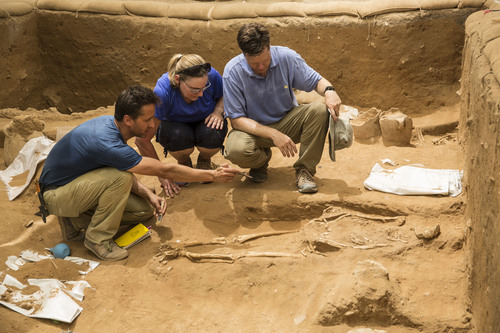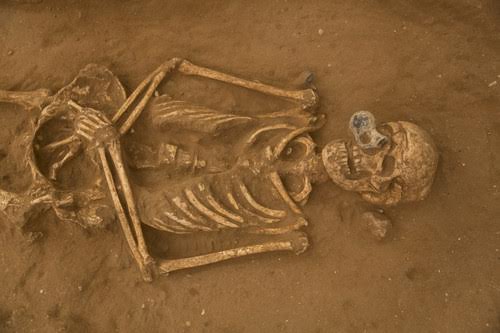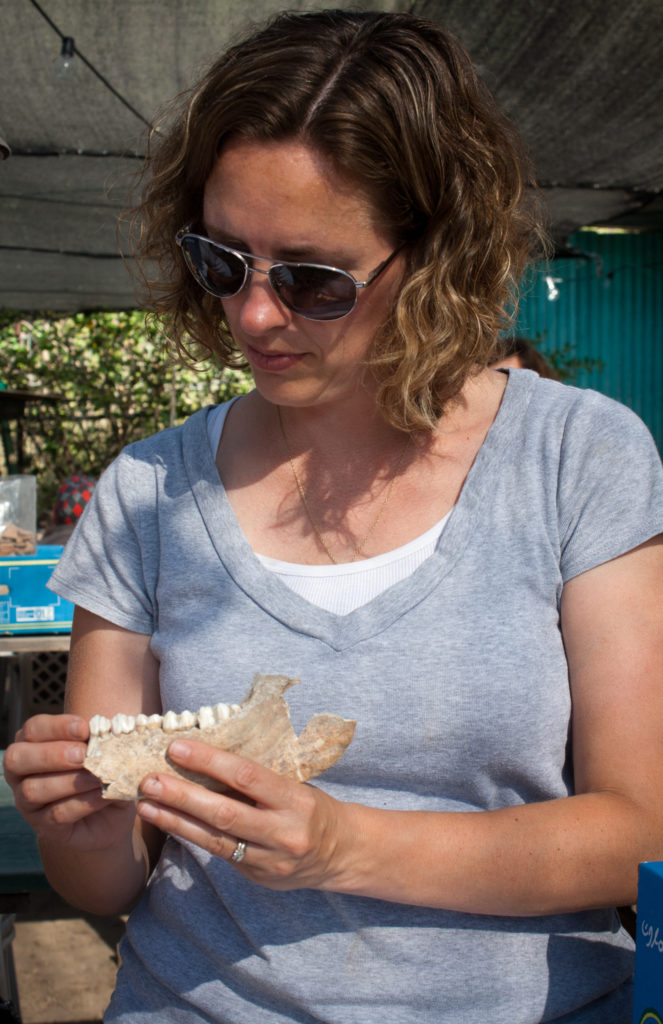Baylor University religion professor Deirdre Fulton is a trained Hebrew, Old Testament and Bible scholar.
But she’s also a zooarchaeologist, which means she’s an expert at studying animal remains found at archaeological sites.
And that’s where the Bible comes into play. Fulton’s training landed her in the middle of a three-year dig that is shedding light on the lives, beliefs and practices of a group often villainized in the Old Testament: the Philistines.

Adam Aja of the Harvard Semitic Museum and Sherry Fox and Daniel Master of Wheaton College consult in the Philistine cemetery at Ashkelon. (Photo/Leon Levy Expedition to Ashkelon)
Fulton was part of a team of archaeologists who excavated a Philistine cemetery in Ashkelon, an ancient city in Israel inhabited by the Philistines during the Iron Age, roughly 1175 to 604 B.C.
While the dig in the city has been going on for some three decades, the cemetery was discovered in 2013 — and was the first Philistine burial ground discovered, according to The Leon Levy Expedition to Ashkelon.
Fulton told Baptist News Global that the cemetery dig is exciting because it may unlock mysteries about the origins of the Philistines, who are widely believed to have been migrants to Israel.
Following is more of what she told BNG about the project.
Before we begin, how does one become a zooarchaeologist?
The normal way you become a zooarchaeologist is you come out of anthropology and you take animal bone archaeology classes. … Then you seek doctoral programs that specialize in that.
I came to zooarchaeology in the strangest way possible. … I was in an archaeology undergraduate major … and went to do graduate work at Penn State. While I was there Brian Hesse, the director the Jewish studies program … needed an assistant in his lab. … He was a very well-known zooarchaeologist working in Israel. I spent seven years working in the lab and gained lots of research and field experience.
How did you become involved with the cemetery dig at Ashkelon?
I got involved at Ashkelon through Brian Hesse and Paula Hesse. … The cemetery was actually excavated between 2013 and 2016. Around 200 bodies were excavated over three seasons.
What is significant, or particularly helpful, about cemetery sites?
A cemetery gives us a lot of information. … We look at artifacts, ceramics, jewelry, weaponry. We are trying to look at the way the Philistines placed their dead with what they considered to be important grave goods. … We look to see … if this looks like other burial behaviors at Ashkelon and we compare them to … other sites in the region. Are there parallels? Does this look like the earlier Canaanite behavior? … We want to know what does a Philistine look like, and grave goods can tell us a lot about their identity and behavior.
Other than Ashkelon, what is known about the Philistines?
The great irony of the Philistines … is that we don’t know what the Philistines thought of themselves. We don’t have written records. We have the written records of their enemies. We have Samson and David and Goliath. We have these stories from the enemies and we have documents in Egypt … and documents from the north of the area, the Hittite area, speaking of a population that comes from the outside. We call them the Sea People. … Basically, what we know of the Philistines comes from the records of the people who didn’t want them there.
What has been learned about the Philistines from the cemetery excavations?
They buried their dead differently from the Bronze Age Canaanites. They laid the body out in a tomb and they had very specific grave goods — a grave kit. That included consecrated oil flasks, a storage jar and a small bowl. … That’s really intriguing that you have one dominant burial behavior going on over many decades and centuries.
Do you get any push back from people who fear these findings could contradict the Bible?
There’s always push back when you study something like biblical archaeology. People think you are taking the biblical stories and reinterpreting them. The Philistines are the enemy, they’re the bad guys. So when you say these are regular people who lived regularly lives, there is always push back from some people on that.
I have to ask: were the Philistines found in the cemetery taller than others who lived in the region?
It’s a question many people asked me and it tells me you have read the Bible and know the Goliath story. The answer is, we are still working on the exact height of all these people.


